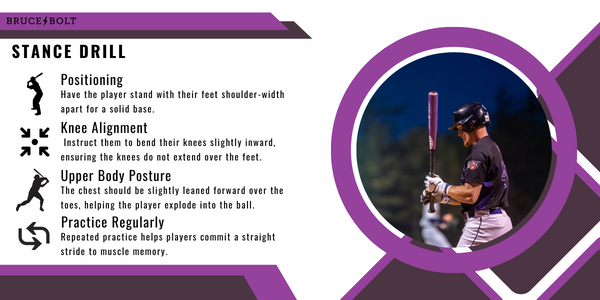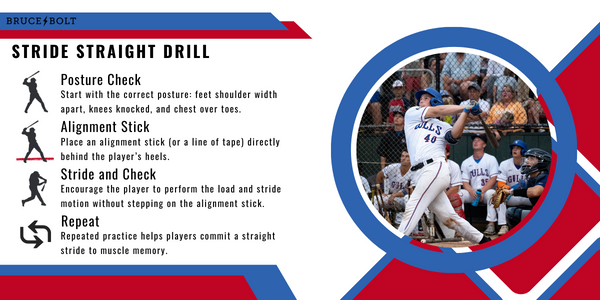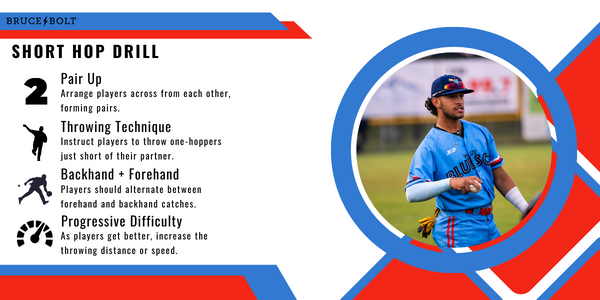Every parent enjoys watching their child step up to home plate, take a confident swing, and watch the ball come off the bat. The cheers from the crowd and the pride in their eyes as they race toward first base is a cherished memory for every family. Of course, the journey to that moment isn't achieved overnight. Practice – in the form of drills – is the path to developing that perfect swing or routine fielding skill. Today, we'll share some of our favorite drills for 7-year-old baseball players. Each drill has been handpicked by our experts at BRUCE BOLT, designed to build foundational baseball skills while keeping the activity engaging and fun.
The Importance of Drills for Young Baseball Players
The beauty of baseball is about more than scoring runs and making incredible catches; it's about the skills young players pick up while playing. And those skills all start with drills. These seemingly simple practices, when executed with accuracy and consistency, can turn into game-changing moments on the field.
From gripping the bat to catching fly balls, every small detail is an opportunity to learn, and drills are precisely what young players need to perfect these details. These drills help 7-year-olds master the fundamentals of the game while also promoting the development of their hand-eye coordination — a crucial skill in baseball. Each drill is designed to uniquely address the training needs of this age group, keeping in mind their attention span and skill level.
Hitting Drills For 7-Year-Olds
Hitting is a difficult yet vital skill in baseball and practicing this at a young age using fun drills can make a big difference as players move from tee ball to coach pitch to Little League. We have shortlisted a few of our favorite batting practice drills which are simple, enjoyable, and crucial in mastering the fundamental techniques of hitting.
Stance Drill
The goal of the stance drill is to develop the correct posture, which is the first step to becoming a great hitter. A good stance is the foundation of all batting skills, providing stability and power during the swing. Here's how to run this drill:
- Positioning: Have the player stand with their feet shoulder-width apart. This width provides a solid base.
- Knee Alignment: Instruct them to bend their knees slightly inward, ensuring the knees do not extend over the feet. This helps maintain balance and power.
- Upper Body Posture: The chest should be slightly leaned forward over the toes. This position readies the player to explode into the ball.
- Practice: Encourage regular practice to reinforce this stance.

Happy Gilmore Drill
Named after the beloved movie character, the Happy Gilmore drill focuses on using momentum to enhance batting power. Ideal for tee ball sessions at home, it combines fun with effective learning. Here's how to proceed:
- Starting Position: Players begin behind the batter's box.
- Step In: They step their back foot into the box first, establishing initial momentum.
- Front Foot Plant: Following the back foot, the front foot plants into the power position, as perfected in the stance drill. This simulates the optimal posture for hitting.
- Drive Through: Players then drive through the baseball, mimicking the hip movement essential for a powerful swing.
- Repeat: Repeat this drill to master the movement.

Stride Straight Drill
Striding correctly towards the ball is a frequent hurdle for young players. This is because many youth baseball players have the common problem of stepping out on their stride or "into the bucket." The stride straight drill teaches them the importance of a straight stride for proper hitting. Here’s a step-by-step guide:
- Posture Check: Start with the correct posture as established in the stance drill.
- Alignment Stick Placement: Place an alignment stick (or even a line of tape) directly behind their feet. This acts as both a guide and a corrective tool.
- Stride and Check: Encourage the player to perform the load and stride motion. If they step on the stick or line, it indicates an incorrect stride.
- Practice: Repeated practice helps players commit a straight stride to muscle memory.

These fun baseball drills are extremely beneficial in teaching the techniques of becoming a skillful hitter. Once your 7-year-old players get the hang of these drills, you will notice a significant improvement not only in their hitting technique but also in their confidence at the plate.
Fielding Drills For 7-Year-Olds
Fielding in baseball is not merely about catching and throwing the ball around the baseball diamond. It's an art founded on timing, positioning, and skill, all of which can be honed with training. Whether at second base, third base, or any other position, your players can excel with the right youth baseball drills. Here are some useful and engaging BRUCE BOLT-approved fielding drills:
Short Hop Drill
The short hop drill is designed to enhance a player's ability to accurately judge and catch short hops, a necessary skill for a solid defensive game. By practicing short hops, players can significantly improve their reaction times and glove skills. Here's how to execute the drill effectively:
- Pair Up: Arrange players across from each other, forming pairs.
- Start Slow: Start with a soft toss for beginners to ensure safety and build confidence.
- Throwing Technique: Instruct players to throw one-hoppers just short of their partner. This technique involves the ball bouncing once before reaching the partner, simulating short hops.
- Catch Variation: Players should alternate between forehand and backhand catches. This variation helps develop versatility in handling ground balls from different angles.
- Progressive Difficulty: As players get better, increase the throwing distance or speed to challenge their skills.

Ping Pong Drill
The ping pong drill is our next drill which is an effective way to improve hand-eye coordination and catching skills. It's simple, fun, and can lead to significant improvements in a player's wrist movement as they go to scoop a ball. Follow these steps to practice the drill:
- Setup: Have the children kneel opposite each other to ensure a manageable distance for the drill. No glove is needed for this drill but the players should use their open glove hand.
- Initial Activity: The first player starts by tossing the ball to their partner on a short hop. The receiving player should then flip the ball back using an open hand with fingers down to the ground.
- Progression: As players become proficient in flipping the ball back, introduce the challenge of snatching the ball (still open palm with fingers towards the ground) and tossing it back instead of flipping it.
- Frequency: Regular practice of this drill can significantly improve players' catching abilities, wrist movement, and response times.

Wall Ball Drill
The wall ball drill is both a challenging exercise and an enjoyable game that focuses on quick reaction times and hand-eye coordination for fielding. This drill is particularly effective in preparing players for real-game scenarios involving quick-reaction plays. Here's how to carry out the wall ball drill:
- Starting Position: The player kneels facing a flat wall, ready to move in any direction.
- Ball Toss: The next player or a coach tosses a tennis ball over the player's shoulder towards the wall. The objective is for the ball to bounce off the wall and return to the player.
- Fielding Practice: The player must react quickly to field the ball with their glove hand. Similar to the ping pong drill, you do not use a glove for this.
- Adaptability: Encourage players to adjust their stance and position based on the ball's trajectory, promoting agility and quick decision-making.
- Progressive Difficulty: To increase the challenge, vary the speed and angle of the throws off the wall.

By integrating these simple drills into your practice sessions, young players can significantly improve their defensive skills, from fielding ground balls to developing hand-eye coordination. Each drill focuses on a specific aspect of fielding, creating a well-rounded approach to defensive training.
Around the Horn: Baseball Drills for 7-Year-Olds
We've now covered a number of drills that will help any 7-year-old master the fundamentals of hitting and fielding. These drills, designed to be fun and engaging, are an excellent way for your young player to understand the level of skill required to play this beautiful game. Whether it's a Saturday evening in the backyard or a competitive practice, these drills can make learning incredibly enjoyable. While we did not have time to cover throwing today, check out our guide on how to throw a baseball for more drills and insights!
From practicing the perfect swing to effortlessly turning double plays, the drills we've discussed not only improve the fundamental skills of the young players but also prepare them for high school baseball and beyond. Remember, the essence of these practice drills isn't always about becoming the next big star, but rather about your child having fun while learning the ropes.

